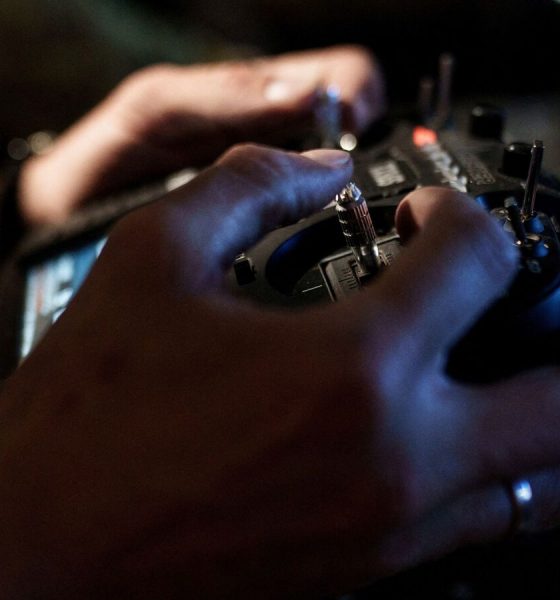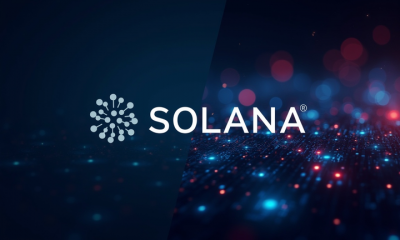
Technology
India’s drone industry grows rapidly but faces critical rare-earth magnet dependency – Crypto News
A key vulnerability lies in the reliance on rare earth magnets—essential for high-performance drone motors, which India currently lacks the capacity to produce at scale, industry executives said. With China tightening export controls on these magnets, especially for defence applications, industry executives warn this could become a bottleneck in India’s goal of building a fully self-reliant drone manufacturing ecosystem.
The motors used in drones are made from rare-earth magnets, typically smaller brushless DC motors. “There are ongoing efforts to identify alternative options—both in terms of materials and designs—and to determine what can be used in place of Chinese-sourced rare earth magnets,” said Sai Pattabiram, founder and MD of Zuppa, a drone-tech startup. Garuda Aerospace invested in the company this year, and it is also backed by MapmyIndia.
“The drone industry hasn’t been drastically impacted yet, but the repercussions are likely to surface soon. That said, solutions will be pursued,” he added. Zuppa says that 80% of their drones are indigenously developed.
Government support
Currently, India is home to 515 drone-related companies, with 263 focused specifically on component manufacturing. In terms of funding, drone startups secured $108 million in 2024 and have already raised $39 million in 2025, according to Tracxn data. India is also set to roll out a $234 million incentive scheme aimed at boosting domestic production of drones for both civil and defence use, according to aReutersreport. Moreover, the production-linked incentive (PLI) scheme, along with initiatives like the defence ministry’s iDEX and Technology Development Fund (TDF), has created a fertile ground for companies to invest in R&D and ramp up manufacturing.
Drone companies interviewed by Mint echoed the sentiment that these schemes are not merely financial boosts, but strategic signals that India is committed to building a globally competitive drone ecosystem.
Key Takeaways
- There are over 515 companies, and over $108 million in funding in 2024, with increasing government support.
- Reliance on foreign-made sensors, controllers, and especially motors powered by rare earth magnets.
- Lack of domestic magnet production and China’s export restrictions threaten industry scalability, especially for defence.
- Companies like Raphe mPhibr are actively working to develop local magnet production, but progress is phased and technology-dependent.
- With modern warfare shifting to drone technology, India’s push for self-reliance and exports presents significant growth opportunities, albeit with technological and supply chain challenges.
Yet, India’s reliance on foreign suppliers—particularly for magnets—has emerged as a serious issue.
“In India, most motors used in drones are permanent magnet motors, which rely on rare earth magnets. Unfortunately, there are currently no alternative suppliers for these magnets,” said Srihari Mulgund, partner and New-Age Mobility leader, EY-Parthenon.
“There is currently no domestic source for drone-grade magnets in India. We need to start figuring this out, especially given the current situation,” he said. With defence applications flagged by foreign suppliers, access to these critical parts becomes even harder. “If the end use is defence-related, then suppliers—especially from China—won’t ship the parts. That’s a serious roadblock. You’re essentially stuck if the supplier flags your application as defence,” Mulgund added.
In June, China issued six-month export licenses for select rare-earth materials following trade talks with the US, but continued to block exports of magnets intended for defence use, maintaining restrictions on military-grade components. “Even automotive companies are struggling to secure these magnets—so how can drone companies expect to fare better?” Mulgund said.
Rare-earth alternatives
Currently, there is no viable recycling mechanism, and substituting with ferrite magnets or soft magnetic composites is not feasible, he added. These alternatives do not offer the same performance characteristics—such as magnetic strength, weight efficiency, or thermal stability—required for high-end drone applications.
Moreover, manufacturers don’t stock large inventories. “Demand is relatively low, as drones aren’t high-volume products; much of the production is order-driven. Companies typically receive an order first and then procure parts, operating largely on a just-in-time basis,” Mulgund said.
Substitutes like ferrite magnets and soft magnetic composites exist but offer significantly lower magnetic strength, making them unsuitable for drones that require compact, high-efficiency components, according to Mulgund.
Yet investor appetite is evolving. As localisation deepens and strategic relevance grows, long-term capital is beginning to flow in.
Recently, Raphe mPhibr raised $100 million, the largest fundraising effort in India’s drone sector to date. However, CEO Vivek Mishra clarified that the funding isn’t for a single product but will go toward expanding both R&D and manufacturing capacities—it is not tied to a specific product like drones.
The startup started in 2017 with a modest 2,000-square-foot research space. Later, it scaled up to a 100,000 sq ft integrated research and manufacturing facility, which has now expanded to a 650,000 sq ft facility.
The company serves over 10 Indian government clients, including the Army, Navy, Air Force, and armed police forces. Mishra said that the company has sold over 400 drones in the past 12 months alone.
On the rare earth magnet front, Mishra said the company has been actively working with authorities and advocating for indigenous manufacturing. “Things have been moving, but they’ve picked up pace over the last couple of months. We are now setting up local manufacturing for these magnets as well. For a few months, there might be certain problems—but it’s solvable,” he toldMint.
Defence capabilities
“There’s growing investment in drone manufacturing in India, but there’s no magic bullet—you can’t just pump in money and expect startups to suddenly make everything indigenous,” said Pushkar Singh, co-founder of investment firm Tremis Capital. “The government is now focusing on manufacturing simpler, less complex components locally, as making high-precision components requires machining expertise we currently lack.”
Less complex components—such as frames, casings, or basic assemblies—are easier and quicker to manufacture compared to high-precision components, which demand advanced machining skills, tighter tolerances, and specialised equipment India is still developing.
He added that while Indian startups are unlikely to make missiles or tanks, drones represent a strategic sweet spot, especially with rising demand in modern warfare. “Modern warfare is shifting towards drones. The government wants to reduce dependency and boost exports. Many smaller countries can’t afford fighter jets or missiles, but they can afford drones. That creates massive export potential for Indian startups.”
Mumbai-based IdeaForge says it has already built a fully proprietary autopilot stack—meaning all flight control software and systems have been developed in-house, without using any third-party or open-source code. “We have written the software for our autopilot from the ground up. The PCB (printed circuit board), which connects and powers key electronic components, is also our own design—and we ensure that microcontrollers (chips that control drone functions), don’t come from geographies of concern (countries that may pose security or trade risks),” said Ankit Mehta, co-founder of IdeaForge. He added that, depending on the product, their drones are around 70% indigenously built.
On rare earths, Mehta said, “It’s not a bottleneck yet—the volume drones need is small. But the supply chain is about to get tested.” While software development timelines can be compressed, “hardware quality takes 1.5–2.0 years to build,” he added.
US, Europe, Japan, Australia, and India have already begun allocating significant resources to rebuild rare-earth supply chains and reduce their dependence on China. Australia’s Lynas Rare Earths has ramped up production, while the US has designated rare earths as critical minerals and is channelling funding into domestic mining and refining. Globally, countries are also investing in recycling technologies to recover rare earths from electronic waste and advancing R&D to develop magnet alternatives and reduce overall rare-earth usage in high-tech applications.
-
others1 week ago
David Schwartz To Step Down as Ripple CTO, Delivers Heartfelt Message to XRP Community – Crypto News
-

 Technology1 week ago
Technology1 week agoEngineers are chasing ₹30 lakh offers—but not from startups – Crypto News
-

 Technology1 week ago
Technology1 week agoEinride Raises $100 Million for Road Freight Technology Solutions – Crypto News
-
others1 week ago
Dogecoin Price Prediction – Chart Set-Up Highlights Perfect Buying Opportunity With Outflows Backing $0.45 – Crypto News
-

 Blockchain1 week ago
Blockchain1 week agoCiti Integrates Token Services Platform With Clearing Solution – Crypto News
-
Technology1 week ago
Fed’s Goolsbee Cites Inflation Worries in Case Against Further Rate Cuts – Crypto News
-

 Technology1 week ago
Technology1 week agoWhich ChatGPT features are restricted under parental controls introduced by OpenAI? – Crypto News
-
others1 week ago
Ireland AIB Manufacturing PMI increased to 51.8 in September from previous 51.6 – Crypto News
-

 Cryptocurrency1 week ago
Cryptocurrency1 week agoBitcoin’s rare September gains defy history: Data predicts a 50% Q4 rally to 170,000 dollars – Crypto News
-

 Cryptocurrency1 week ago
Cryptocurrency1 week agoBitcoin’s Cheat Code? 50 EMA Could Decide BTC’s Price in Q4 – Crypto News
-

 others1 week ago
others1 week agoGBP/USD rises as Fed rate cut bets grow, US shutdown risks loom – Crypto News
-
Technology1 week ago
Bloomberg Analyst Says XRP ETF Approval Odds Now 100% as Expert Eyes $33 Rally – Crypto News
-

 Blockchain2 days ago
Blockchain2 days agoIt’s About Trust as NYSE Owner, Polymarket Bet on Tokenization – Crypto News
-
Business1 week ago
Bitcoin Price Set to Rebound Ahead of US Government Shutdown, NFP Data – Crypto News
-
Technology1 week ago
Breaking: BNB Chain Account Hacked With Founder CZ Shown Promoting Meme Coin – Crypto News
-

 Technology1 week ago
Technology1 week agoUS SEC weighs tokenised stock trading on crypto exchanges – Crypto News
-

 Blockchain1 week ago
Blockchain1 week agoWatch These Key Bitcoin Metrics as BTC Price Prepares for ‘Big Move’ – Crypto News
-

 Technology1 week ago
Technology1 week agoNasdaq-listed Helius Medical Technologies rebrands as Solana Company – Crypto News
-

 Cryptocurrency1 week ago
Cryptocurrency1 week agoCrypto Market Prediction: Shiba Inu (SHIB) Moon Landing, Dogecoin (DOGE) Trapped in $0.23, XRP: Most Important Event for $3 – Crypto News
-

 Blockchain1 week ago
Blockchain1 week agoThe Bullish Pattern That Suggests New Highs – Crypto News
-

 Blockchain1 week ago
Blockchain1 week agoTrump Pulls Brian Quintenz Nomination for CFTC – Crypto News
-
Technology1 week ago
Crypto ETFs Approval Faces Uncertainty as Government Shutdown Looms, Bloomberg Analyst Says – Crypto News
-

 Cryptocurrency1 week ago
Cryptocurrency1 week agoBitcoin Bounces as Crypto Market Turns Green: Where Do Prices Go Next? – Crypto News
-
Cryptocurrency1 week ago
BREAKING: BlackRock Amends Bitcoin ETF (IBIT), Ethereum ETF (ETHA) Amid New Milestone – Crypto News
-

 Cryptocurrency1 week ago
Cryptocurrency1 week agoXPL, Not XRP: Why Are Whales Shoveling Ripple’s Rival? – Crypto News
-

 De-fi1 week ago
De-fi1 week agoCrypto Market Slips as U.S. Government Shutdown Looms – Crypto News
-

 Technology1 week ago
Technology1 week agoCAKE eyes 60% rally as PancakeSwap hits $772B trading all-time high – Crypto News
-

 De-fi1 week ago
De-fi1 week agoAndre Cronje’s Flying Tulip Raises $200 Million Ahead of ICO – Crypto News
-

 others1 week ago
others1 week agoEUR/GBP supported by dovish BoE tone and persistent UK fiscal headwinds – Crypto News
-

 Cryptocurrency1 week ago
Cryptocurrency1 week agoHorizen (ZEN) gains 12% to break above $7 – Crypto News
-
others1 week ago
Japan Tankan Large All Industry Capex climbed from previous 11.5% to 12.5% in 3Q – Crypto News
-

 Blockchain1 week ago
Blockchain1 week agoAnalyst Outlines Longevity And Bold $200 Target – Crypto News
-
others1 week ago
Fed’s Hammack Backs Restrictive Policy Over Rate Cuts Amid Inflation Concerns – Crypto News
-

 De-fi1 week ago
De-fi1 week agoHyperliquid’s Hypurr NFTs Settle at $55,000 Floor Amid Ecosystem Expansion – Crypto News
-
Business1 week ago
Crypto Stakeholders Push Back as Banks Seek Yield Ban Provision in CLARITY Act – Crypto News
-

 Technology1 week ago
Technology1 week agoGoogle Nano Banana trend: 50 AI prompts to transform men’s selfies into retro-golden Durga Puja portraits – Crypto News
-
others1 week ago
Japan Industrial Production (YoY) declined to -1.3% in August from previous -0.4% – Crypto News
-

 Technology1 week ago
Technology1 week agoChainlink and Swift allow banks to access blockchain through existing systems – Crypto News
-
Technology1 week ago
Breaking: BNB Chain Account Hacked With Founder CZ Shown Promoting Meme Coin – Crypto News
-
others1 week ago
Japan Foreign Investment in Japan Stocks rose from previous ¥-1747.5B to ¥-963.3B in September 26 – Crypto News
-
Business1 week ago
Legal Expert Breaks Down XRP’s Appeal as Ripple SWIFT Debate Heats Up – Crypto News
-

 Cryptocurrency1 week ago
Cryptocurrency1 week agoBitcoin Climbs Above $112K, But $125K Resistance Looms Large – Crypto News
-
Technology1 week ago
SEC Chair Paul Atkins Says Crypto Is Top Priority At SEC CFTC Roundtable – Crypto News
-

 Cryptocurrency1 week ago
Cryptocurrency1 week agoEthereum whales return to the market: Is ETH ready for $10K? – Crypto News
-

 Technology1 week ago
Technology1 week agoFTT price on the edge as FTX creditors brace for $1.6B payout on Sept. 30 – Crypto News
-

 De-fi1 week ago
De-fi1 week agoCrypto Market Edges Up as Investors Weigh Fed Moves and Government Shutdown Risks – Crypto News
-
others1 week ago
New Zealand ANZ Business Confidence fell from previous 49.7 to 49.6 in September – Crypto News
-

 Blockchain1 week ago
Blockchain1 week agoDX Terminal Tops NFT Sales Count in September as Base Dominates Top 10 – Crypto News
-

 Blockchain1 week ago
Blockchain1 week agoDX Terminal Tops NFT Sales Count in September as Base Dominates Top 10 – Crypto News
-

 Metaverse1 week ago
Metaverse1 week agoWho is Alexandr Wang? Meta AI chief and 28-year-old billionaire urges teens to spend ‘all their time’ on this activity – Crypto News










